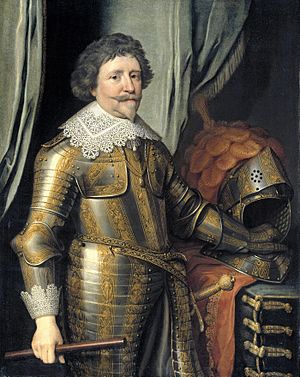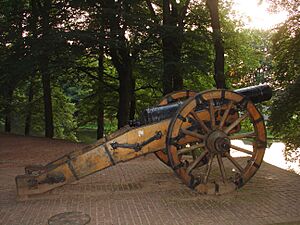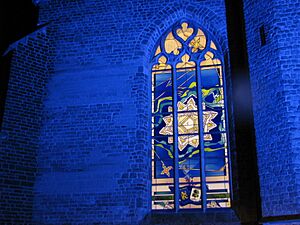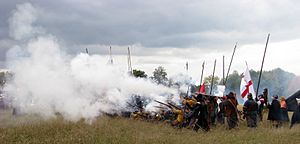Siege of Groenlo (1627) facts for kids
Quick facts for kids Siege of Groenlo |
|||||||
|---|---|---|---|---|---|---|---|
| Part of the Eighty Years' War and the Anglo–Spanish War | |||||||
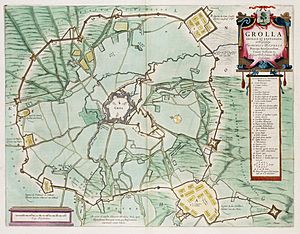 Siege of Groenlo in 1627 by Frederick Henry, including the circumvallation. Map J.Blaeu. |
|||||||
|
|||||||
| Belligerents | |||||||
| Commanders and leaders | |||||||
(Spanish Army) |
|||||||
| Strength | |||||||
| 16,000 infantry 4,000 cavalry |
1,200 infantry (Grol) 100 cavalry (Grol) 16,000 infantry (Spanish Army) 5,000 cavalry (Spanish Army) |
||||||
| Casualties and losses | |||||||
| Unknown | Unknown | ||||||
The Siege of Grol in 1627 was an important battle. It took place during the Eighty Years' War and the Anglo–Spanish War. The battle was fought between the army of the Dutch Republic and the city of Grol. Grol, now called Groenlo, was controlled by Spain.
The Dutch army was led by Frederick Henry, Prince of Orange. The Spanish forces in Grol were commanded by Matthijs Dulken. A Spanish army led by Hendrik van den Bergh tried to help Grol, but they arrived too late. The siege lasted from July 20 to August 19, 1627. It ended with Grol surrendering to the Dutch army.
During the siege, the Dutch built a huge wall around Grol. This wall was 16 kilometers (10 miles) long. It was called a circumvallation line. Its purpose was to stop anyone from leaving Grol. It also prevented outside armies from helping the city. This victory was the first major land success for the Dutch Republic after a 12-year break in fighting.
Contents
Why Grol Was Important
Even though Grol was a small city, it was very important for military reasons. Grol was a busy trading center. It was also well-fortified with strong defenses and weapons. Its location was key because it was on a major Hanseatic trade route to Germany.
The land around Grol was marshy and hard to reach. This meant that whoever controlled Grol controlled the whole area. Maurice of Nassau had captured Grol in 1597. But Spinola took it back for Spain in 1606. Grol stayed in Spanish hands until the Dutch captured it in 1627.
Grol was a good place for Spanish troops to stay. It also served as a base for Spanish attacks. The city collected high taxes and fees from the nearby regions. This brought a lot of money to the Spanish army. Grol, along with other fortified towns, could be used to attack the Dutch Republic from the east. After the Dutch captured Oldenzaal in 1626, they decided to focus on taking Grol.
Getting Ready for the Siege
The Dutch army, led by Frederick Henry, had over 15,000 foot soldiers and 4,000 cavalry. They traveled by foot and by boat along the Rhine river. Most of the soldiers were mercenaries from different parts of Europe. These included Scottish, English, German, Frisian, and French troops. The English forces were commanded by Edward Cecil.
The army arrived at Grol on July 20, 1627. They immediately blocked all main roads leading to the city. About 1,000 carts brought supplies. These included gunpowder, bullets, 75 guns, food, and all the tools needed for the siege.
Building the Great Wall
The next day, thousands of soldiers and hired workers started building a huge earthen wall around Grol. This wall was 10 feet high and 16 kilometers (10 miles) long. They also built wooden and earthen ramparts, trenches, and other fortifications. These included fortified camps for the troops.
Frederick Henry had troops of the same nationality work together. So, the English troops built an "English fort" (Engelse Schans). There were also forts for the French, Frisian, and Dutch troops. Guns were placed in smart spots to defend the wall from all sides. The guns in Grol could not reach this wall, as it was 2 kilometers (1.2 miles) away. The wall was finished in just 10 days. However, it was made even stronger throughout the siege.
Frederick Henry knew that a large Spanish army was nearby. This army was led by his cousin, Hendrik van den Bergh. To keep the Spanish army busy and delay their arrival, Frederick Henry pretended to attack another town, Goch. This helped him avoid a big battle in the open field. Dutch commanders also took over villages around Grol. This stopped the Spanish from getting a foothold nearby. Guards were placed everywhere, and supply lines were set up to bring food and supplies to the large army.
The Siege Begins
Inside Grol's Walls
Matthijs Dulken, a skilled commander, led the Spanish army inside Grol. He had 1,200 foot soldiers and about 100 cavalry. Dulken ordered his troops to make the city's defenses even stronger. He told them to harm the enemy in any way they could.
Once the great wall was ready, the Dutch army started firing cannons at Grol. Dutch, English, and French troops also began digging tunnels towards the city. Any damage to Grol's defenses was quickly repaired by the people inside. However, the Dutch shot 200 "fireballs" into the city. These caused a lot of damage to buildings and people. Dulken himself was shot in the shoulder. He then gave command to Lambert Verreyken. Verreyken and his cavalry attacked the Dutch digging positions. But these attacks did not cause many casualties. Inside Grol, two barrels of gunpowder exploded by accident. This killed forty people.
Fighting Outside Grol
Meanwhile, the English digging team reached the canal around Grol. This canal was fed by the Slinge river. To cross it, the Dutch blew up a lock north of the city. This lowered the water in the canal by five feet, leaving it nine feet deep.
Next, the Dutch army tried to build a dam to cross the canal. But they faced heavy gunfire from Grol. The city also poured burning oil, which destroyed the dam. Finally, with help from two cannons, the attackers built two dams. Many soldiers died, including two English officers. After crossing the canal, they began to dig under Grol's outer walls. Attacks from the city continued during this time.
Van den Bergh Arrives
While the siege continued, Van den Bergh and his large Spanish army arrived near Groenlo. They had also picked up 1,800 German mercenaries. His army was now bigger than Frederick Henry's. However, they lacked money and supplies. They had also arrived too late for a direct battle in the open field.
Van den Bergh's army fired their guns so Grol would know help was near. He tried to cut off the Dutch army's supply lines. But this plan failed because of arguments between Spanish and Italian troops. He then decided to attack the great wall (circumvallation line). He hoped to break through to Grol. His attack on the Scottish fort seemed to work at first. But a strong counterattack by Officer Morre pushed the Spanish away. This ended all hope for Van den Bergh's victory.
Ending the Siege
Frederick Henry then tried to talk to Dulken. He wanted to convince him that the Spanish army outside could not save Grol. Dulken, who had recovered from his wound, proudly refused. The siege continued.
English troops crossed the canal and placed a mine under one of Grol's outer defenses. The mine exploded on August 18. It created a huge hole in the defenses. English troops rushed in, climbing the city's earthen walls. But Verreyken was waiting with hundreds of muskets and burning tar. He pushed back the English three times, causing many deaths. However, Dulken was smart enough to know his city would soon be attacked from three sides. He also realized he was short on men and guns. So, he asked for a break in fighting and sent negotiators.
The Agreement
An agreement was signed three days later. It was similar to the one used after the siege of Breda. The city was handed over to the Dutch Republic. The Spanish troops and citizens in Grol were allowed to leave. They could take their weapons and loot. But they could only take two guns. Frederick Henry loaned 200 carts for the defenders to carry their equipment, as agreed.
He placed Dutch foot soldiers and horsemen in Grol. This was to defend it from future attacks. The entire great wall was destroyed, and all trenches were filled. This was to prevent future attackers from using them. The Archbishop of Utrecht, Philippus Rovenius, who was in the city during the siege, was allowed to leave. Grol was now under the Dutch Republic and remained so until the end of the war.
The victory was celebrated greatly in the Dutch Republic. The Spanish had finally been defeated after many losses. Hugo de Groot wrote all the details of the battle. Joost van den Vondel wrote a long poem about the siege. The saying Zo vaste as Grolle (as sturdy as Grolle) became popular. It referred to how hard it was to capture the city.
Grol Today
Groenlo, the old Grol, was influenced by the city of Munster. It was under Spanish Catholic control for many years. Today, it remains a Catholic area in a mostly Protestant region. Many famous artists of that time painted scenes from the siege.
In the town of Groenlo, cannons and parts of the old walls have been restored. These are for historical and tourism purposes. Live reenactments of the 1627 events happen regularly. These events, called the 'Slag om Grolle', attract many people. In recent years, more parts of the original great wall are being found. There are discussions about restoring the full 16-kilometer (10-mile) line.
From 2006 to 2007, the old Calixtus church in Groenlo was renovated. A new stained glass window showing the 1627 siege was added. The church survived all six sieges that Groenlo went through in the 16th and 17th centuries. After the 1627 siege, the Dutch government paid for a church window that was broken during the fighting.
In the hot Dutch summer of 2003, a small plane found mysteriously green plants in a dry corn field. These plants showed the outlines of the French fort from 1627 (Franse Schans). The old canals around the fort changed the soil or water flow, keeping the plants green. The English fort was found earlier near Lievelde. It has been fully restored and can be visited.
Reenactment Events
The 'Battle of Grolle' is a regular historical reenactment of the siege. It takes place in and around Groenlo every two years. The event lasts for three days. It includes a historic battle reenactment and a historic fair. The first event was held in 2005. Since then, reenactors from France, Germany, the United Kingdom, the Czech Republic, and the Netherlands have taken part. The most recent reenactment was in October 2022.
Images for kids
See also
 In Spanish: Sitio de Groenlo (1627) para niños
In Spanish: Sitio de Groenlo (1627) para niños





